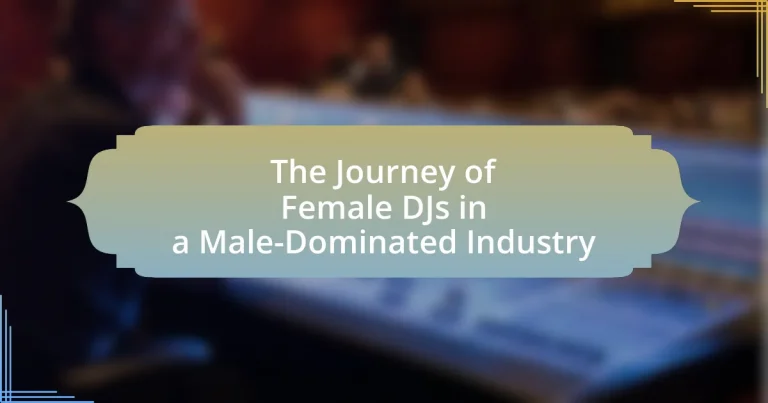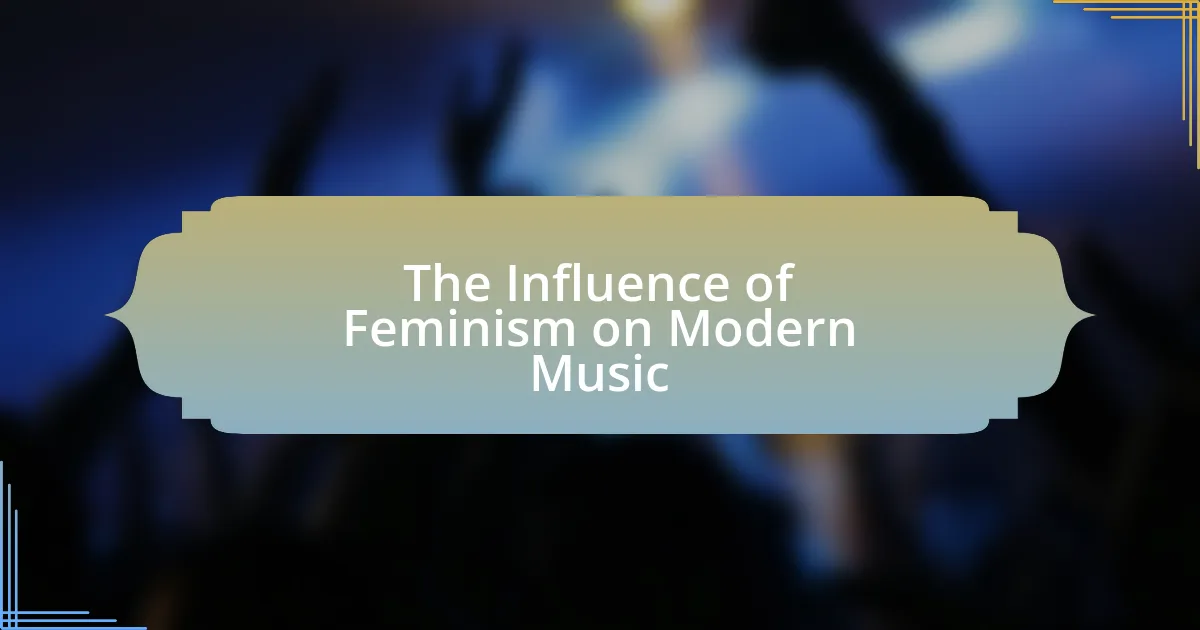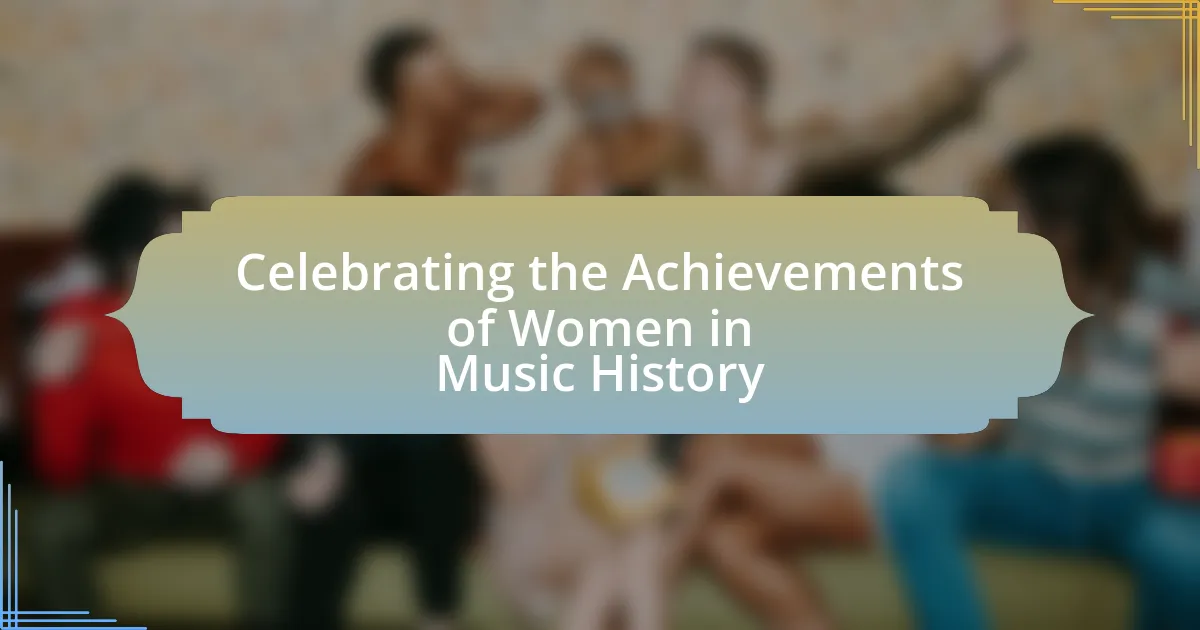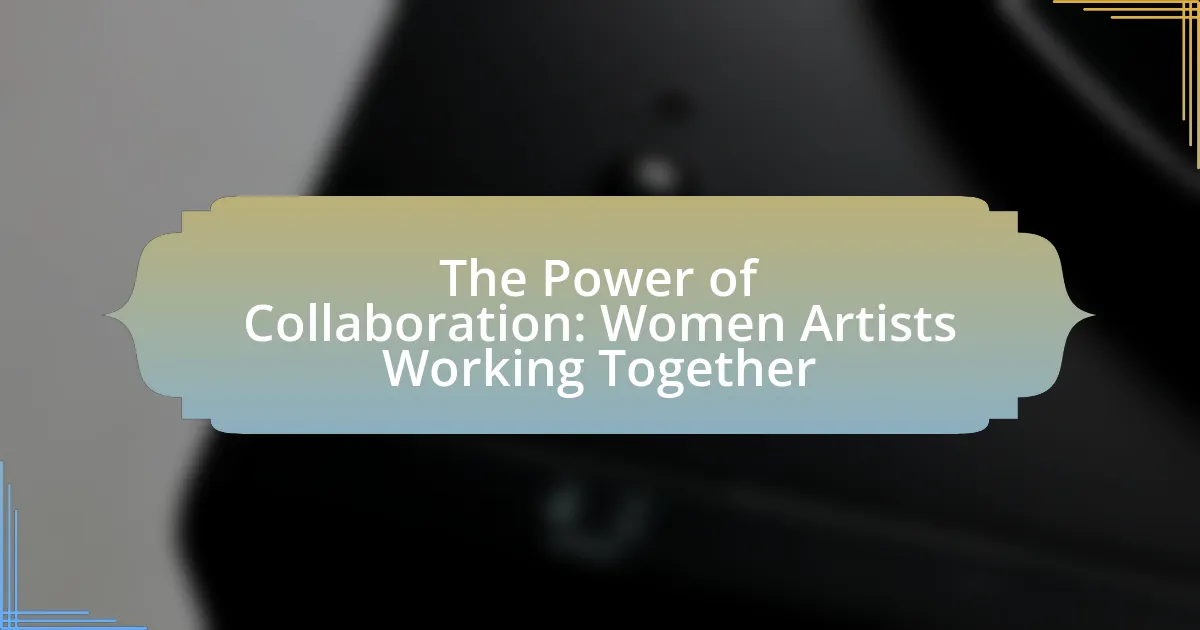The article examines the journey of female DJs within the male-dominated music industry, highlighting their significance in challenging gender stereotypes and promoting diversity. It discusses the influence of female DJs on the music scene, their unique perspectives, and the barriers they face, including gender bias and limited representation. The evolution of the landscape for female DJs is explored, along with historical milestones and the impact of technology and social media on their opportunities. Additionally, the article addresses current trends, challenges, and practical strategies for aspiring female DJs to enhance their careers in a competitive environment.
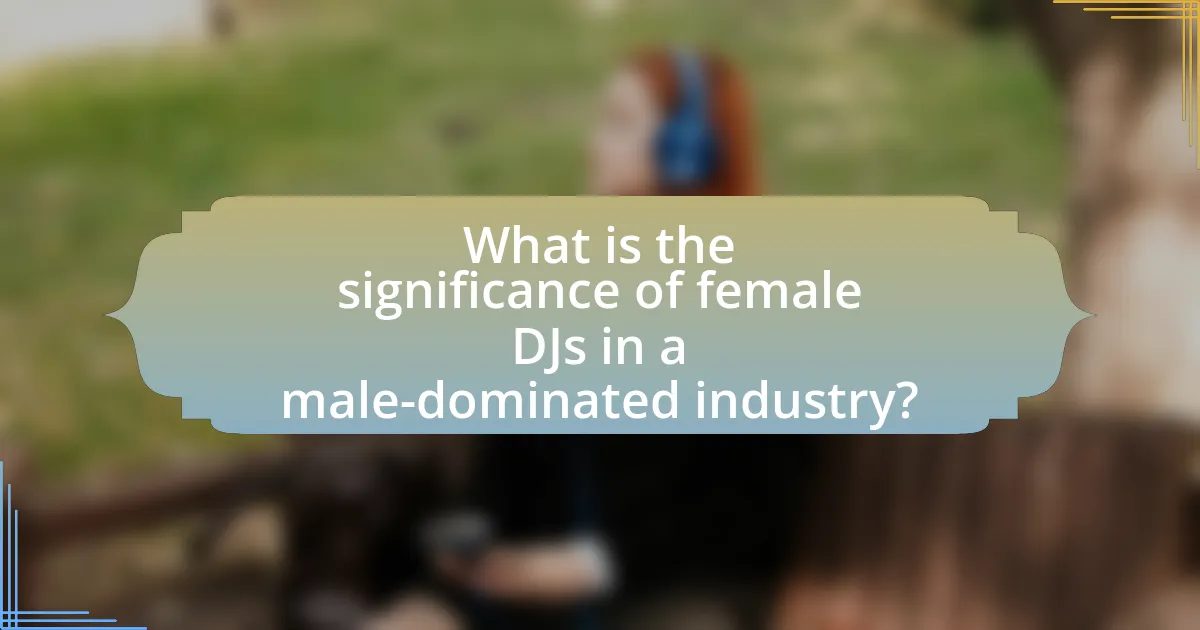
What is the significance of female DJs in a male-dominated industry?
Female DJs play a crucial role in challenging gender stereotypes and promoting diversity within the male-dominated music industry. Their presence not only inspires aspiring female artists but also contributes to a broader cultural shift towards inclusivity. For instance, studies show that events featuring female DJs often attract diverse audiences, enhancing the overall experience and fostering community engagement. Additionally, the rise of female DJs like Nina Kraviz and Charlotte de Witte has led to increased visibility and recognition for women in electronic music, demonstrating that talent transcends gender. This significance is further underscored by initiatives aimed at supporting women in music, such as the SheSaidSo network, which empowers female creatives and promotes gender equality in the industry.
How have female DJs influenced the music scene?
Female DJs have significantly influenced the music scene by breaking gender barriers and reshaping perceptions of women in electronic music. Pioneers like Annie Mac and Nicole Moudaber have not only gained recognition for their skills but have also inspired a new generation of female artists. According to a 2020 report by the Association for Electronic Music, female representation in DJing has increased, with women now making up approximately 20% of the DJing community, compared to just 5% a decade ago. This shift has led to more inclusive lineups at festivals and clubs, promoting diversity and challenging the male-dominated status quo.
What unique perspectives do female DJs bring to their craft?
Female DJs bring diverse perspectives to their craft, often influenced by their unique experiences and challenges in a male-dominated industry. These perspectives include a heightened sensitivity to audience dynamics, which allows them to create more inclusive and varied playlists that resonate with a broader demographic. Research indicates that female DJs often prioritize emotional connection and storytelling in their sets, fostering a more engaging atmosphere. Additionally, their presence challenges gender stereotypes, inspiring other women to enter the field and contributing to a gradual shift towards gender equality in electronic music. This shift is supported by statistics showing an increase in female representation at major music festivals, highlighting the impact of female DJs on the industry.
How do female DJs challenge traditional gender roles in music?
Female DJs challenge traditional gender roles in music by breaking stereotypes and asserting their presence in a predominantly male industry. They redefine the image of a DJ, showcasing that skill and creativity are not limited by gender. For instance, female DJs like Nina Kraviz and Charlotte de Witte have gained international acclaim, headlining major festivals and influencing the electronic music scene. Their success not only inspires aspiring female artists but also encourages a shift in industry perceptions, promoting gender equality and diversity. This shift is evidenced by increasing visibility and representation of women in DJ lineups, which has risen from 10% in 2015 to over 30% in recent years at major festivals, indicating a significant change in the landscape of the music industry.
What barriers do female DJs face in the industry?
Female DJs face significant barriers in the industry, including gender bias, lack of representation, and limited access to opportunities. Gender bias manifests in the form of stereotypes that question their technical skills and credibility compared to male counterparts. According to a 2019 study by the Association for Electronic Music, only 10% of DJs at major festivals are women, highlighting the lack of representation. Additionally, female DJs often encounter challenges in networking and securing gigs, as industry connections are predominantly male-dominated, which further restricts their access to opportunities.
What are the common stereotypes associated with female DJs?
Common stereotypes associated with female DJs include the belief that they are less skilled than their male counterparts, that they rely on their appearance to gain recognition, and that they are primarily focused on playing mainstream or commercial music. These stereotypes stem from a historically male-dominated industry where female DJs often face skepticism regarding their technical abilities and musical knowledge. Research indicates that only 10% of DJs in major festivals are women, highlighting the gender disparity and reinforcing these stereotypes. Additionally, a study by the University of Southern California found that female DJs frequently encounter assumptions about their competence based solely on their gender, which can hinder their professional opportunities and visibility in the industry.
How do these barriers impact their career progression?
Barriers such as gender bias, lack of representation, and limited access to networking opportunities significantly hinder the career progression of female DJs in a male-dominated industry. These obstacles often result in fewer performance opportunities, reduced visibility, and challenges in gaining recognition compared to their male counterparts. For instance, a study by the University of Southern California found that female DJs are often overlooked for gigs and festival lineups, which directly impacts their ability to build a fan base and establish a successful career. Additionally, the prevalence of stereotypes can lead to a lack of mentorship and support, further stalling their professional growth.
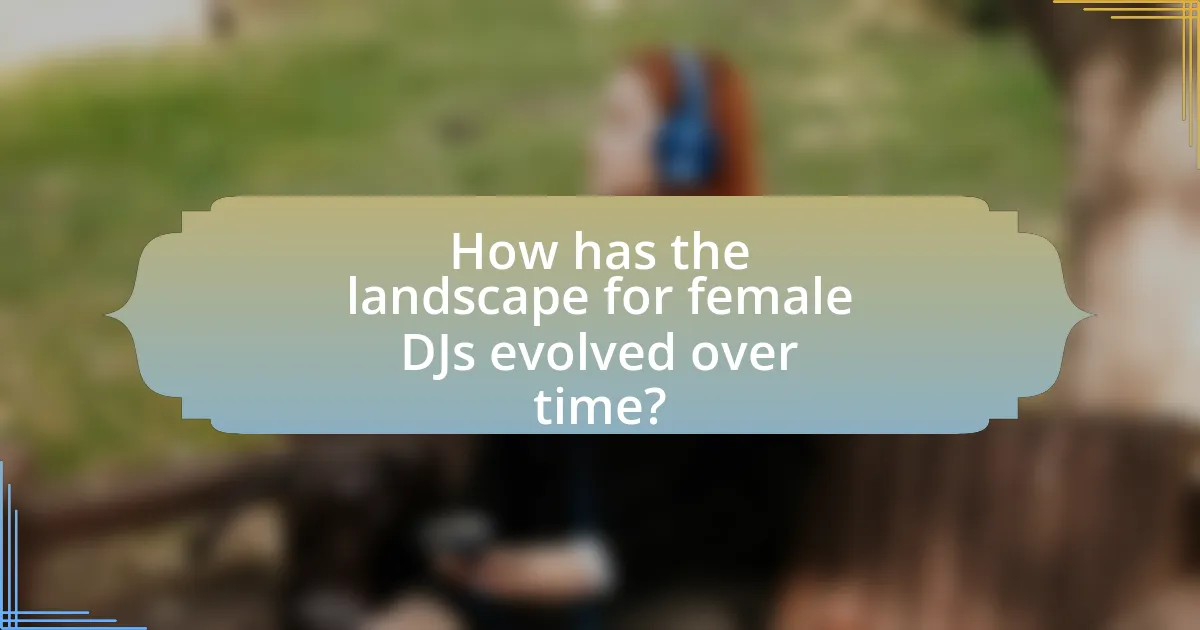
How has the landscape for female DJs evolved over time?
The landscape for female DJs has evolved significantly over time, transitioning from a predominantly male-dominated field to a more inclusive environment. In the 1980s and 1990s, female DJs faced considerable barriers, often receiving less recognition and fewer opportunities compared to their male counterparts. However, the rise of electronic dance music (EDM) in the 2000s brought increased visibility and acceptance for women in the industry, exemplified by artists like Tiësto and David Guetta collaborating with female DJs and producers.
By 2018, a report from the International Music Summit indicated that the percentage of female DJs had increased to 20%, up from just 10% in previous years, showcasing a growing presence in festivals and clubs. Additionally, initiatives such as SheSaidSo and the Femme House movement have actively promoted female talent, providing mentorship and support. This evolution reflects broader societal changes towards gender equality, enabling female DJs to gain recognition and establish successful careers in a once male-dominated industry.
What historical milestones have marked the journey of female DJs?
The journey of female DJs has been marked by several significant milestones, including the emergence of pioneering figures in the 1970s and 1980s, such as Kool Lady Blue and DJ Spinderella, who broke gender barriers in hip-hop and dance music. In 1990, the first all-female DJ collective, the “Sisterhood,” was formed, promoting female talent in a male-dominated industry. The 2000s saw increased visibility for female DJs, exemplified by the rise of artists like Samantha Ronson and Annie Mac, who gained mainstream recognition. In 2013, the first female DJ to win the prestigious DJ Mag Top 100 DJs poll, DJ Miss Kittin, highlighted the growing acceptance and success of women in the field. These milestones reflect the evolving landscape for female DJs, showcasing their contributions and influence in the music industry.
Who are some pioneering female DJs that paved the way?
Some pioneering female DJs who paved the way include Annie Mac, DJ Spinderella, and Ellen Allien. Annie Mac, a prominent figure in the UK music scene, has been influential in promoting electronic music and supporting emerging artists through her BBC Radio 1 shows. DJ Spinderella, known for her work with Salt-N-Pepa, broke barriers in hip-hop and showcased the role of female DJs in a predominantly male genre. Ellen Allien, a Berlin-based DJ and producer, has significantly impacted the techno scene and founded the successful label BPitch Control, further establishing women’s presence in electronic music. These women have not only contributed to their genres but have also inspired future generations of female DJs.
What changes in technology have influenced female DJs’ opportunities?
Advancements in technology have significantly expanded opportunities for female DJs by providing accessible tools for music production and performance. The rise of digital audio workstations (DAWs) like Ableton Live and FL Studio has democratized music creation, allowing women to produce and mix tracks from home without needing expensive studio time. Additionally, the proliferation of social media platforms enables female DJs to showcase their work, build a following, and connect with audiences globally, which was not as feasible in the past. According to a 2021 report by the International Music Summit, female representation in electronic music has increased, partly due to these technological advancements that empower women to enter and thrive in the industry.
How has the perception of female DJs changed in recent years?
The perception of female DJs has significantly improved in recent years, with increased recognition and acceptance within the music industry. This shift is evidenced by the rise of prominent female DJs such as Charlotte de Witte and Peggy Gou, who have gained international acclaim and headlined major music festivals. Additionally, studies indicate that the representation of women in DJ lineups has increased, with events like Tomorrowland and Coachella featuring more female artists than ever before. This change reflects a broader cultural movement towards gender equality in the music scene, challenging the historical male dominance in the industry.
What role do social media and online platforms play in this change?
Social media and online platforms play a crucial role in empowering female DJs within the male-dominated music industry by providing visibility and access to audiences. These platforms enable female DJs to showcase their work, connect with fans, and build personal brands without the traditional barriers of entry that often exist in the industry. For instance, a study by the University of Southern California found that social media has significantly increased the representation of women in music, allowing them to gain recognition and support through platforms like Instagram and SoundCloud. This democratization of exposure helps to challenge gender stereotypes and fosters a more inclusive environment in the DJ scene.
How have recent festivals and events showcased female talent?
Recent festivals and events have prominently showcased female talent by featuring a significant number of female DJs and artists in lineups, thereby increasing visibility and representation in the music industry. For instance, major festivals like Coachella and Tomorrowland have included female headliners and performers, highlighting their contributions to electronic music. In 2022, Coachella featured artists such as Billie Eilish and Megan Thee Stallion, while Tomorrowland’s lineup included prominent female DJs like Charlotte de Witte and Amelie Lens. This trend reflects a growing recognition of female talent, as evidenced by reports indicating that female artists now make up approximately 30% of festival lineups, a notable increase from previous years.
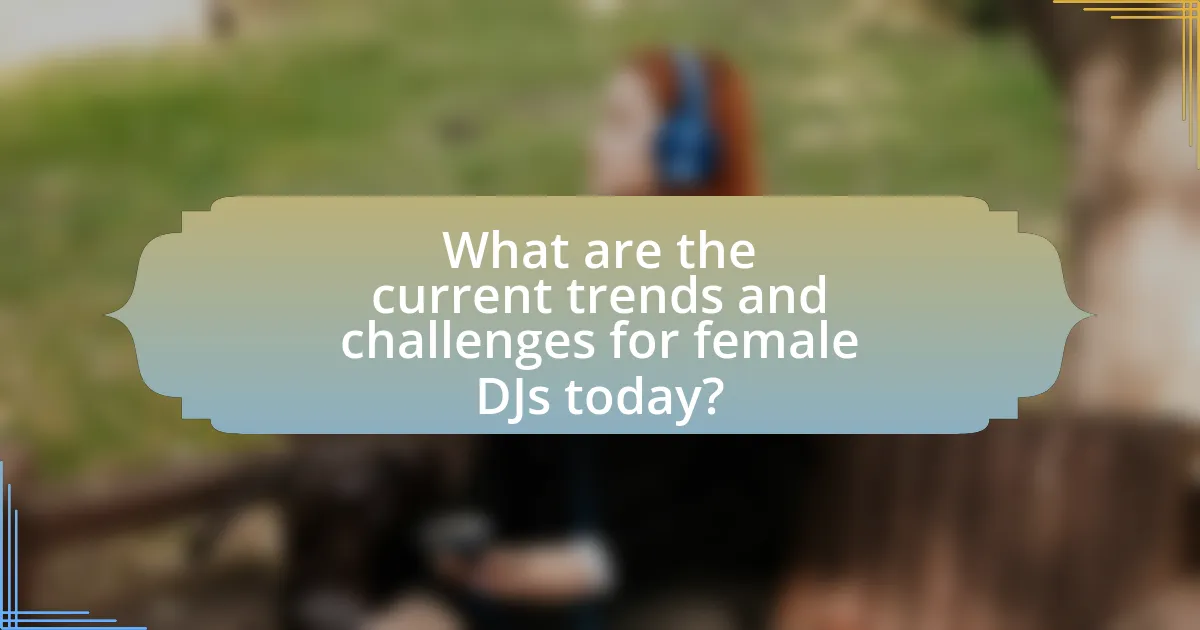
What are the current trends and challenges for female DJs today?
Current trends for female DJs include increased visibility and representation in the music industry, with more women headlining major festivals and gaining recognition in mainstream media. Challenges persist, such as gender bias, underrepresentation in lineups, and difficulties in accessing resources and networking opportunities. According to a 2022 report by the Association for Electronic Music, only 20% of festival lineups feature female DJs, highlighting the ongoing struggle for equality in a predominantly male-dominated field.
What opportunities exist for female DJs in the modern music industry?
Female DJs have numerous opportunities in the modern music industry, including increased visibility through festivals, collaborations, and social media platforms. The rise of music festivals that prioritize diversity has led to more female DJs being booked, with events like Coachella and Tomorrowland actively promoting gender equality in their lineups. Additionally, collaborations with established artists can enhance a female DJ’s profile, as seen with artists like Alison Wonderland and Rezz, who have gained recognition through partnerships. Social media platforms, particularly Instagram and TikTok, provide avenues for female DJs to showcase their skills, build a fanbase, and connect with industry professionals, further expanding their opportunities in a traditionally male-dominated space.
How are collaborations with other artists shaping their careers?
Collaborations with other artists significantly shape the careers of female DJs by expanding their audience reach and enhancing their creative versatility. When female DJs collaborate with established artists, they gain exposure to new fan bases, which can lead to increased bookings and visibility in a competitive industry. For instance, collaborations often result in chart-topping tracks that can elevate a DJ’s status, as seen with artists like Nina Kraviz and her work with various producers, which has helped her gain international recognition. Additionally, these partnerships foster skill development and innovation, allowing female DJs to experiment with different styles and genres, thereby enriching their artistic identity and marketability.
What role do mentorship and community play in supporting female DJs?
Mentorship and community play a crucial role in supporting female DJs by providing guidance, networking opportunities, and a sense of belonging in a predominantly male industry. Female DJs often face unique challenges, including gender bias and limited access to resources; mentorship helps them navigate these obstacles by offering advice and sharing experiences. Community initiatives, such as female DJ collectives and workshops, foster collaboration and empowerment, enabling women to build confidence and skills. Research indicates that women who engage in supportive networks are more likely to succeed in their careers, highlighting the importance of mentorship and community in enhancing visibility and opportunities for female DJs.
What challenges do female DJs still face in the industry?
Female DJs still face significant challenges in the industry, primarily including gender bias, lack of representation, and limited access to opportunities. Gender bias manifests in the form of skepticism regarding their skills and talent, often leading to fewer bookings compared to their male counterparts. According to a 2020 study by the International Music Summit, only 2% of festival line-ups featured female DJs, highlighting the stark underrepresentation in prominent events. Additionally, female DJs often encounter a lack of mentorship and networking opportunities, which are crucial for career advancement in a male-dominated environment. These challenges collectively hinder their ability to establish a strong presence and gain recognition in the industry.
How do issues of representation and visibility affect female DJs?
Issues of representation and visibility significantly hinder female DJs by limiting their opportunities and recognition in a predominantly male industry. Female DJs often face challenges such as underrepresentation in lineups at major festivals and clubs, which can perpetuate stereotypes and discourage aspiring female artists. For instance, a 2019 study by the Association for Electronic Music found that only 14% of festival lineups featured female DJs, highlighting the disparity in visibility. This lack of representation not only affects the career advancement of female DJs but also influences audience perceptions, making it harder for them to gain credibility and support within the music community.
What strategies can female DJs employ to overcome these challenges?
Female DJs can employ several strategies to overcome challenges in a male-dominated industry, including building a strong personal brand, networking effectively, and leveraging social media for visibility. Establishing a unique identity helps female DJs differentiate themselves and attract a dedicated audience. Networking with other industry professionals can provide support, mentorship, and opportunities for collaboration, which are crucial for career advancement. Additionally, utilizing social media platforms allows female DJs to showcase their work, engage with fans, and promote events, thereby increasing their presence in the industry. These strategies are supported by the growing number of female DJs gaining recognition and success, indicating a shift towards greater inclusivity in the music scene.
What practical tips can aspiring female DJs consider for success?
Aspiring female DJs can achieve success by focusing on building technical skills, networking effectively, and developing a unique brand. Mastering DJ equipment and software is essential, as proficiency in mixing and sound manipulation enhances performance quality. Networking with industry professionals and attending events can create opportunities for gigs and collaborations, which are crucial in a competitive landscape. Additionally, establishing a distinct personal brand helps female DJs stand out; this includes curating a unique musical style and engaging with audiences on social media platforms. According to a 2021 study by the International Music Summit, female DJs represent only 10% of the industry, highlighting the importance of visibility and representation for aspiring female artists.
How can networking enhance opportunities for female DJs?
Networking enhances opportunities for female DJs by providing access to industry contacts, collaborations, and mentorship. Establishing connections with other DJs, producers, and event organizers can lead to gigs, promotional opportunities, and support in navigating the male-dominated music industry. For instance, a study by the University of Southern California found that women in music who actively networked reported higher rates of career advancement and job opportunities compared to those who did not engage in networking. This demonstrates that building relationships within the industry is crucial for female DJs to gain visibility and credibility, ultimately leading to increased opportunities for performances and collaborations.
What skills should female DJs focus on developing to thrive in the industry?
Female DJs should focus on developing technical skills, networking abilities, and performance confidence to thrive in the industry. Technical skills include mastering DJ equipment, software, and music production, which are essential for creating unique sets and standing out. Networking abilities are crucial for building relationships with other industry professionals, securing gigs, and gaining visibility. Performance confidence helps female DJs engage audiences effectively and assert their presence in a predominantly male environment. According to a 2020 study by the International Music Summit, only 2% of festival line-ups featured female DJs, highlighting the importance of these skills for overcoming industry barriers and achieving success.
